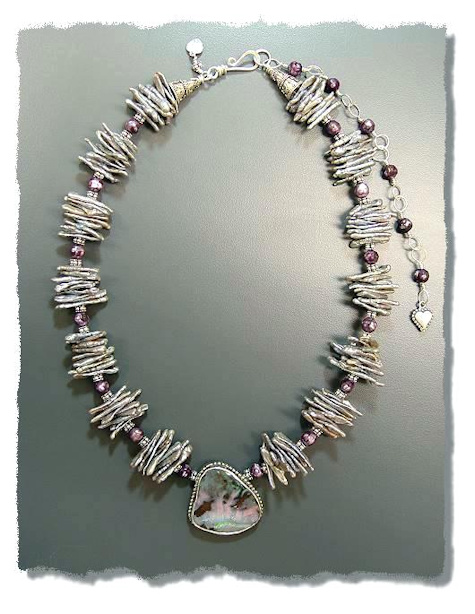In Australia, boulder opals form in brown ironstone. This one had "50.48cts" printed on its label but most of that 50cts was of boulder, not opal! You see, vendors like to sell you the whole rock if they can, even though the opalized portion may be a relatively thin layer as in this example. I don't care, what I look for is a beautiful picture. Whoever cut this stone very carefully exposed the thin opal layer leaving a sculptural surface. Again, I enjoy seeing the natural contours. I'm explaining all this because I don't want you to imagine this is a fine gem opal, it's not. Fine gem opal would be all opal and full of fire, but perhaps it would not have a great image like this stone has. I cut fully 1/3 of the brown ironstone away from the back so I could set it. You will notice I set at a bit of an angle so the beautiful waterfall and river would be level and the abode of the magical deer would be evident. And can you imagine a better place to find a magical deer than beside a pink waterfall and iridescent river? One story of a magical deer comes from don Juan as you may recall.
The deer on the reverse is adapted from an image at El Batequi in Baja California, one location where Baja's famous cave paintings occur. I have had the great good fortune to visit a very few of the cave paintings but I have not been to this site. Crosby describes it thus: "it dawned on me that unity and composition were its greatest glories. The mural is clearly not the work of a single artist; ... It is certainly the product of many generations." [emphasis mine] At this point, radiocarbon dating of various sites proves him correct. On a single wall, the overlapping images appear to have been separated by as much as 3,000 years. It is difficult to imagine a civilization lasting 3,000 years in the Baja desert to begin with, and even harder to realize that we know nothing about the painters at all (aside from the legend that they were giants). There is virtually no trace of them save for these magnificent murals.
So, back to our little opal! Some people are superstitious about wearing opals, but Kunz points out that until fairly recently, the opal was thought to combine all the virtues of the various colored gems whose hues are united in it. Simmons and Ahsian praise the virtues of various opal types as well. So please order this beautiful necklace, I hope it will help you to find your own magical deer.







